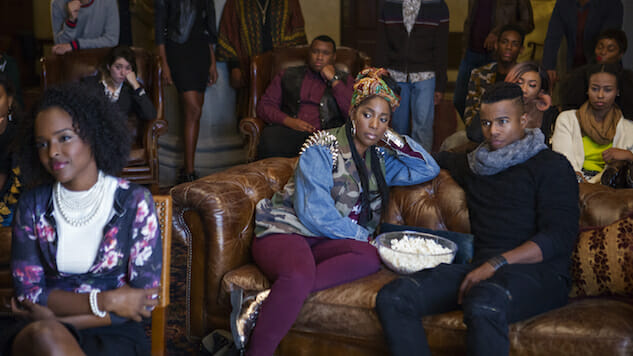
If you’re reading this, my guess is that you love watching TV. And guess what? Your favorite TV characters love watching TV, too. One of TV’s most delightful inside jokes comes in the form of the show-with-in-a-show: the faux comedy, drama or reality program that plays in the background as the characters continue on with their lives. The show that they just can’t stop talking about and gather around to watch.
These embedded wink-winks—including the most recent, Kev’Yn, a Martin-inspired sitcom revival that appears in the new season of Insecure—are a way for showrunners to slyly communicate with the audience, respond to viewer criticism, or comment on a particular aspect of pop-culture or the television industry. Sometimes they’re just trying to make us laugh.
Here are our 15 favorite shows within a show. Note: This list includes only shows the characters watch, not fictional shows the characters star in—so no TGS from 30 Rock or Seeing Red from The Comeback (sorry, Valerie!) You’ll have to keep an eye out for those on our upcoming list of the best backstage TV shows.
15. Vidas del Fuego
Show: Ugly Betty

The ABC dramedy was itself based on the popular Colombian telenovela Yo Soy Betty La Fea, so it made total sense that Betty (America Ferrera) and the rest of the Suarez clan would be hooked on Vidas del Fuego, which centered on a pregnant maid who is having an affair with her priest and a stepmother seducing her stepson in order to get control of the family fortune. A telenovela inside a telenovela is the TV version of those Russian nesting dolls, and it was perfect. In a forward-thinking move at the time (this was back in 2006), ABC even offered weekly webisodes of Vidas del Fuego. We’re sorry/not sorry we watched. —Amy Amatangelo
14. The Terrence and Phillip Show
Show: South Park
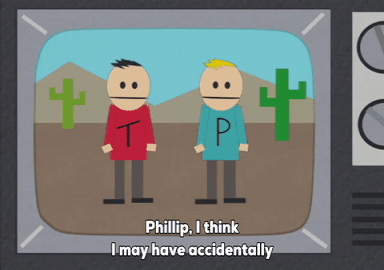
If South Park was knocked for its elementary animation and immature humor, creators Matt Stone and Trey Parker doubled down with The Terrence and Phillip Show, which makes South Park seem like something from Studio Ghibli by comparison. The crass Canadian stick figures are to the parents of South Park, Colo., what Stan, Kyle, Cartman and Kenny are to the real-world parents who write off South Park as an obscene waste of time. After 21 seasons, Stone and Parker have explored the world behind the show within the show to the point that Sir Phillip Niles Argyle and Sir Terrance Henry Stoot have gone from two kids yelling “You FAH-ted!” to Buddhist monks and Nobel Peace Prize winners. So there’s hope for Cartman yet. —Josh Jackson
13. Inspector Spacetime
Show: Community
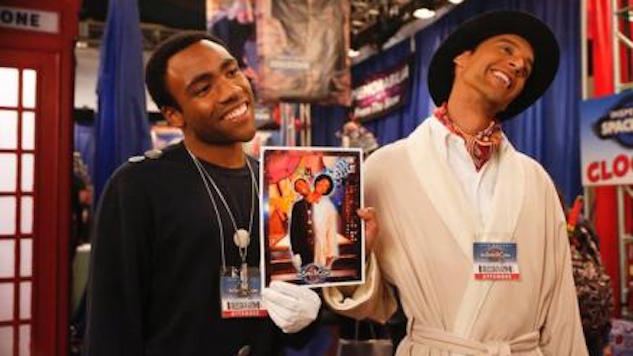
The incredibly British and incredibly fake Doctor Who parody Inspector Spacetime helped strengthen Community’s most affecting friendship. Though Abed (Danny Pudi) learned of the show from Britta (Gillian Jacobs), it’s through Troy (Donald Glover) and Abed’s appreciation of the multi-incarnate (and sometimes very sexy) time-and-space traveling Inspector that the show within the show found its place in the tightknit group of friends. Fighting cybernetic Blorgons with a Quantum Spanner is one thing, but providing a specific interior fandom for a show that spawned a cultish fandom of its own made two of its characters even more relatable to Community viewers. Plus, the “Inspector Spacetime Christmas Special” is a hilarious jab at Star Wars inside of a larger stab at Doctor Who. No geeky sci-fi property is safe. —Jacob Oller
12. All My Circuits
Show: Futurama
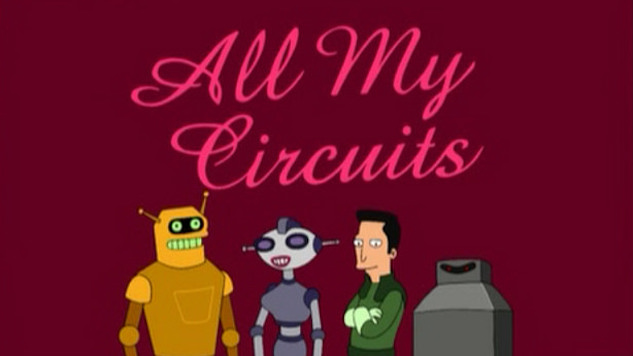
As the robotic soap opera (isopropyl alcohol opera? What do you clean electronics with?) at the heart of Futurama’s grand actorly takedown character, Calculon, All My Circuits isn’t just a great show within a show, it’s the basis for opening the show to an entire field of parody. Futurama needed a grounding media system that audiences could relate to—hence why the news desk sees so much airtime as well—so that the future felt real and just as ridiculous as our present. Gimmicky movie fads (like when the All My Circuits hit theaters with a choose-your-plot voting system), actor culture, and, of course, ridiculous melodramatic reveals all felt the zap of the show’s hilarious sparks. The recurring gag’s popularity made its breakout character appear in both the show and its sub-show, often in the same episode. Now that’s media saturation. —Jacob Oller
11. Big Shot: For the Bounty Hunters
Show: Cowboy Bebop

Cowboy Bebop may have been ahead of its time in its mixture of medium and tone, but that doesn’t mean the series’ writers were averse to a simple plot-helper or two as they propelled Spike, Jet, Faye, Ed and Eine along. Enter Big Shot, a slimmed down America’s Most Wanted for all those bounty hunters trying to make ends meet in 2071. Hosted by Punch and Judy (no relation), the western-themed show could always be relied on to provide the show’s characters (and viewers) with timely, action-spurring insight into a past, current or future target. (Judy’s outfit also provided plenty of teenagers with their first anime crush.) Alas, the show within a show’s run was even shorter than the series that contained it—Big Shot is cancelled in Session 23, much to the surprise and chagrin of its co-hosts. (Keep an eye out for one final appearance from the actor playing Punch a few episodes later.) —Michael Burgin
10. Interdimensional Cable
Show: Rick & Morty
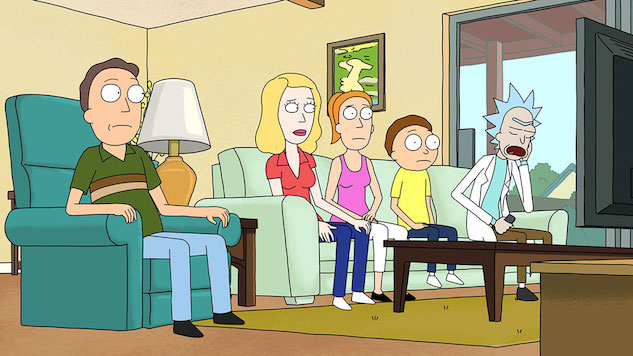
Its less-successful reprise in “Interdimensional Cable 2: Tempting Fate” and “Morty’s Mind Blowers” suggests that part of its appeal was the element of surprise, but the introduction of interdimensional cable—think “peak TV,” Rick and Morty style—in Season One’s “Rixty Minutes” remains one of the series’ most exquisitely lunatic gambits. Featuring short, twisted, improvisational riffs on every genre and subgenre from the infinite multiverse—and a few, like an ad starring electronics salesman Ants in My Eyes Johnson, that are unclassifiable—Rick and Morty’s channel-surfing condenses the series’ surreal, pitch-dark understanding of popular culture into perfect miniature. “Rixty Minutes” also, fittingly, features Rick and Morty’s unofficial motto: “Nobody exists on purpose, nobody belongs anywhere, everybody’s gonna die,” Morty (Justin Roiland) says to his crestfallen sister, Summer (Spencer Grammer), near episode’s end. “Come watch TV?” —Matt Brennan
9. Everything on Stan’s TV
Show: Gravity Falls
We spent a whole 20-item list going into raptures over the weird and wild adventures gotten into by Mabel and Dipper Pines during their summer in the supernaturally saturated town of Gravity Falls. But while those weird and wild adventures are for sure the spine of Gravity Falls, it’s all the moments of utter familial mundanity that fill every space in between cosmic calamities that make the Pines twins’ world feel so true. Nothing is more utterly mundane than an old man’s bored family gathering around an equally old CRT television set to eat snacks and zone out together over whatever happens to be playing, be it a procedural about a duck detective of startling intuition, a game show shameless enough to wear its money-chasing viciousness right on its sleeve, or whatever is on the “Black and White Period Piece Old Lady Boring Movie Channel.” Sure, the kids made memories chasing down sasquatches and conspiracy theories in the Gravity Falls woods, but they made everlasting bonds gathered on the ratty living room rug with Wendy, Soos, Waddles and their Grunkle Stan around that old box of a TV set. — Alexis Gunderson
8. Ghostfacers
Show: Supernatural
Sam (Jared Padalecki) and Dean (Jensen Ackles), monster fighters with hearts of gold (and muscles of steel), do not watch television. Well, OK, they do sometimes—gotta occupy those rare stretches between demons, vampires, ghosts and imaginary friend-murdering serial killers somehow—but when they do, it’s Scooby-Doo and Dr. Sexy, M.D. for Dean, and All My Children for Sam. What they absolutely do not watch is the Internet-based shaky-cam reality series Ghostfacers, which features Ed Zeddmore (A.J. Buckley), Harry Spangler (Travis Wester) and their colleagues Maggie (Brittany Ishibashi), Kenny (Austin Basis) and Alan (Dustin Milligan) as tech-laden supernatural “experts” “hunting” “ghosts” all across America. That is, doing exactly what Sam and Dean do, but with none of the skills, knowledge, or harrowing personal tragedies to back their work up. The only reason we in the audience know about Ghostfacers at all, then, is that the two ghost-hunting (“ghost-hunting”) teams end up crossing deadly paths, whose lead-up and aftermath we witness through the Ghostfacers’ lenses, on an episode of Ghostfacers—an episode in which, not for nothing, Sam and Dean only show up eleven minutes in, a fact which simultaneously makes this episode an easy “in” for anyone who’s never fallen into the Supernatural well. The Ghostfacers never take over Supernatural’s literal gig the same way in any of their subsequent appearances, but after this big first swing right out of the gate, they don’t have to: Sam, Dean, and everyone at home watching have their number. —Alexis Gunderson
7. MILF Island
Show: 30 Rock
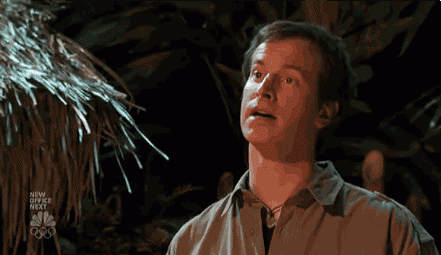
“25 super-hot moms. 50 eighth-grade boys. No rules.” How’s that for a tagline? See, at first you think Jack Donaghy’s (Alec Baldwin) summer reality hit sounds preposterous. But then you realize it’s 2018 and we’re still talking about Omarosa. Or that CBS just green-lit an American version of the British hit Love Island. Or that the Bachelorette just picked a seemingly racist suitor as the winner. < i>MILF Island becomes more feasible by the minute. As with all things 30 Rock, this evisceration of our fascination with trashy reality shows was just close enough to the truth to make it hilarious. In the words of Liz Lemon (Tina Fey), “I didn’t come here to make friends. I came here to be number one.” —Amy Amatangelo
6. The Valley
Show: The O.C.

Welcome to The Valley, bitch. (Sorry, I’m contractually obligated to begin any discussion of The O.C. with that phrase.) The Fox teen drama was the epitome of adolescent angst (brooding bad boys, star-crossed love), and series creator Josh Schwartz loved to engage with his viewers even when their affection waned and fans grew critical. From the show’s first season, Summer (Rachel Bilson) was a huge fan of The Valley, and this faux teen soap about teens in the San Fernando Valley provided Schwartz with a great way to have a conversation with his viewers and let them know he heard their complaints and concerns. When The O.C. struggled in its second season, so did The Valley. The whole thing was over-the-top meta, but we loved it anyway. —Amy Amatangelo
5. Defamation and Prince O’Palities
Show: Dear White People
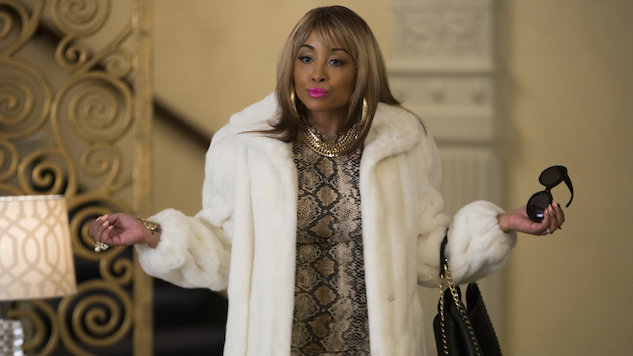
It’s not terribly surprising that Justin Simien’s college-set series, the freshman season of which featured the expert Scandal parody Defamation, should traffic in meta-textual references: As Simien is prone to say, shade is his love language, and TV is ripe for trolling. What differentiates Dear White People from, say, Insecure—with its inspired Underground goof, Due North—or the formidable tag team of The Good Wife and The Good Fight—whose Darkness at Noon is a more trenchant dig at “prestige” dramas than most of us critics have yet mustered—is the sheer density of its TV trolling. In Season Two alone, the perfect Empire send-up Prince O’Palities is joined by Season One holdover Dereca: Set Me Straight, a frankly deranged (i.e., brilliant) caricature of Iyanla: Fix My Life, a Love & Hip-Hop spoof, and more gags on cables news blather than you can shake a fist at. Add to that Lena Waithe’s arc as a closeted rapper named P. Ninny and a cameo as black conservative commentator Rikki Carter by Tessa Thompson—who starred in the 2014 film on which the series is based—and Dear White People comes closer to BoJack Horseman for media in-jokes per minute than any other live-action TV series. —Matt Brennan
4. Conjugal Visits, Due North and Kev’Yn
Show: Insecure
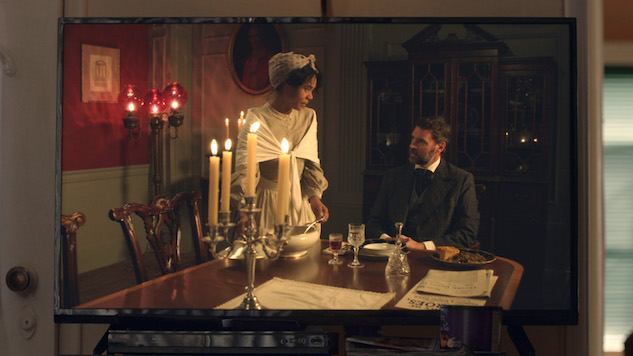
Like most groups of friends, Issa (Issa Rae) and Molly (Yvonne Orji) like to sit around watching their favorite shows. They eat in front of the TV and discuss what’s happening. The difference is, their favorite shows just happen to capture what is in the zeitgeist at the moment. The first season’s Conjugal Visits ripped a page from trashy TV shows we know we shouldn’t watch but can’t stop anyway. Due North, which featured Scott Foley and Regina Hall, was an Underground/Empire/Scandal extravaganza. For the third season, Rae and showrunner Prentice Penny kicked it up a notch. Not only is Kev’Yn, starring Bill Bellamy and Erika Alexander (and directed by Kim Fields!!), a Martin spoof, it’s also a reboot of a comedy that aired years ago. Despite the many (so many!) reboots happening right now, there isn’t any talk of rebooting popular shows that starred black actors. Like, seriously, where is the Living Single revival? Leave it to Insecure to give us the reboot we didn’t even know we needed. —Amy Amatangelo
3. Darkness at Noon and Talking at Noon
Show: The Good Wife
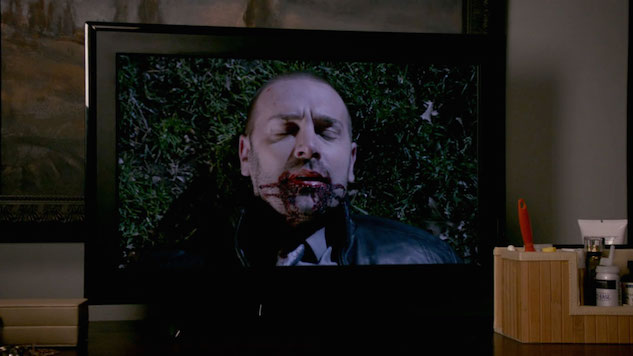
By the fifth season, it appeared that series creators and executive producers Robert and Michelle King had had it. Had it with the moody, dark, depressing, male-driven, dare I say misogynistic dramas dominating the awards shows and receiving all the critical praise. The short-lived AMC series Low Winter Sun was the straw that broke the camel’s remote. The Kings could remain silent no longer, and Darkness at Noon was born in “Parallel Construction, Bitches.” The episode kicked off with a “previously on” that seems so real many people checked to make sure they were watching the right channel. The show would weave in and out of the series often, with Alicia (Julianna Margulies) watching it with a perplexed look. Talking at Noon, the after-show that discussed the minutiae of Darkness at Noon à la Talking Dead, popped up in The Good Wife’s sixth season, with the hosts gleefully declaring everything about Darkness at Noon to be “badass.” This kind of meta commentary was The Good Wife’s sweet spot, and it was glorious. —Amy Amatangelo
2. Invitation to Love
Show: Twin Peaks
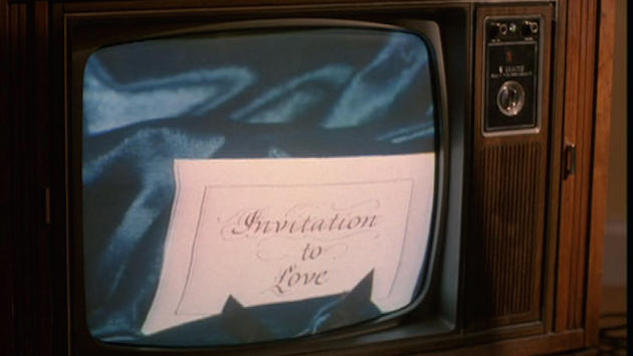
Twin Peaks’ relentless obsession with mirrors, reflections and doubles was a mystifying but often artistically thrilling element of David Lynch’s game-changing show. Sometimes the effect was chilling, sometimes just plain weird, nearly always provocative and occasionally even funny. Its most goofball manifestation was arguably Invitation to Love, a daytime soap that appeared as background noise in the lives of several principal characters. The soap out-soaped actual soaps with its absurd, lurid plotlines, which occasionally seemed to mirror events going on in secret in the deceptively wholesome small town of Twin Peaks, and also featured (how could it not) an actress who played ridiculous identical twins, one good, one evil. The show within a show was at once a sendup of a genre the larger show often imitated and a symbolic super-trope, and it pulled it off without ever showing us more than a few seconds of screen time. —Amy Glynn
1.The Itchy & Scratchy Show
Show: The Simpsons
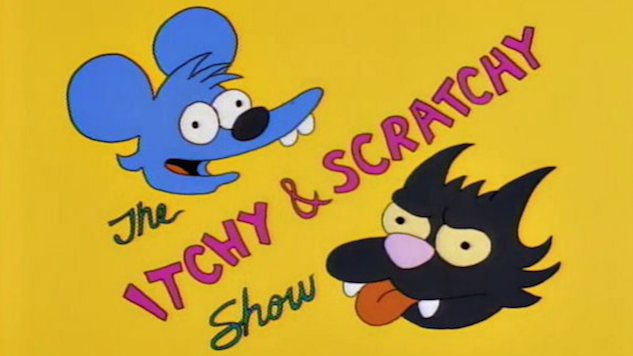
The Simpsons has combined the conventions of sitcom, satire and cartoon to gleefully skewer every facet of American culture since it first appeared as a show within a show on The Tracey Ullman Show in 1988. Its own show within a show within a show (it appears within episodes of The Krusty the Clown Show), The Itchy & Scratchy Show is an ongoing dissertation on gratuitous violence based largely on the cartoon Tom and Jerry, and features a homicidal mouse who continually finds freakishly grisly ways to kill a cat. Itchy & Scratchy primarily functions as a device for extrapolating social commentary, typically expanding an issue being explored by the Simpsons episode in which it appears, often satirizing the satire and sometimes becoming a key part of the primary storyline—or a meta-commentary on the phenomenon of The Simpsons. (An episode in which Homer Simpson becomes the voice for a catastrophic, ratings-tanking dog named “Poochie” stands out as perhaps the single most concise example of Itchy & Scratchy as a critique of The Simpsons itself.) Creator Matt Groening is said to have been strongly influenced by Disney’s 101 Dalmatians, in particular being fascinated by the scene in which the puppies watch TV. That revelation of how a cartoon within the context of a cartoon might function galvanized one of the most thoroughly harvested examples of the genre, and thousands of grisly cat-killings later, we’re still laughing. And then laughing at the fact that we’re laughing. And… well, you get the picture. —Amy Glynn
Amy Amatangelo, the TV Gal®, is a Boston-based freelance writer, a member of the Television Critics Association and the Assistant TV Editor for Paste. She wasn’t allowed to watch much TV as a child and now her parents have to live with this as her career. You can follow her on Twitter (@AmyTVGal) or her blog .